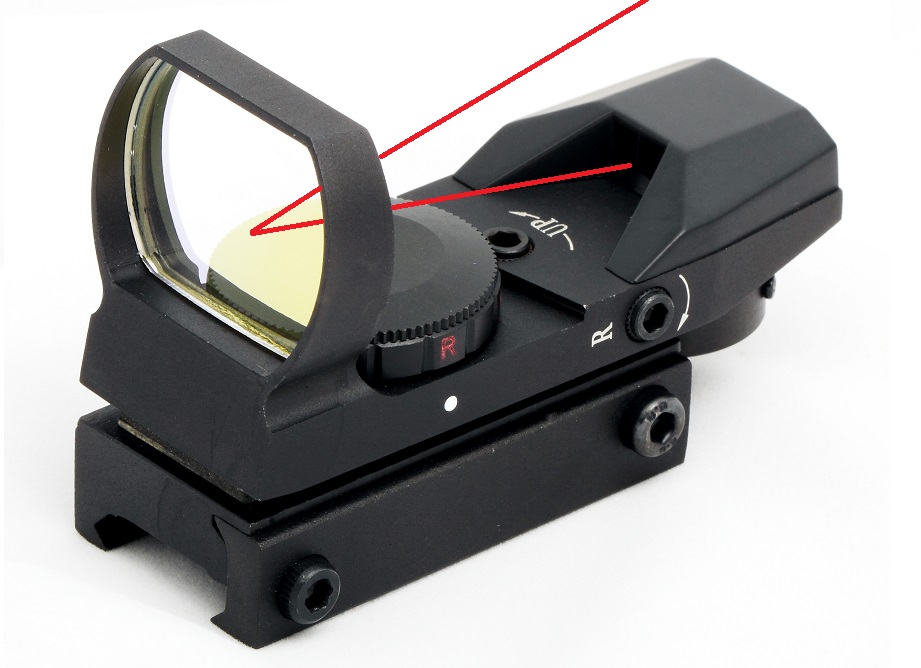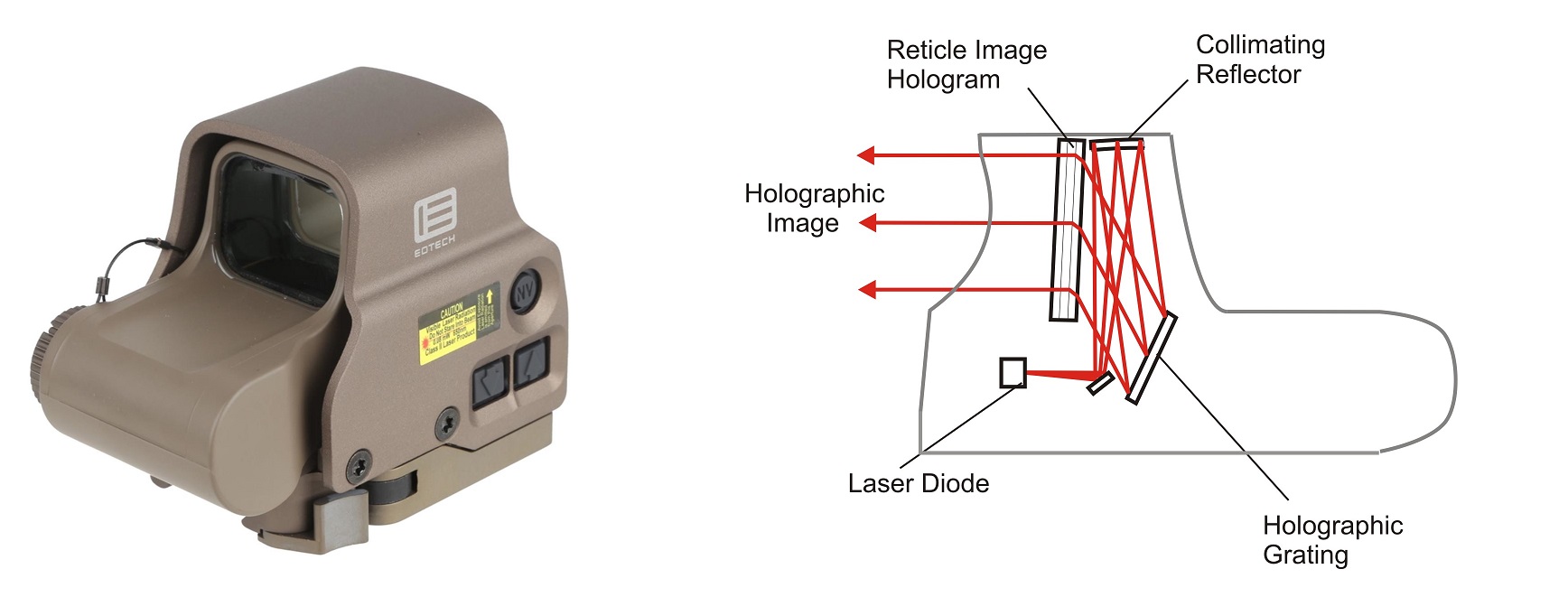Holographic vs. Red Dot Sights: Which to Pick?
Posted by Gun Builders Depot on Feb 1st 2022
Reflex and holographic optics look like each other, and they produce an aiming reticle that looks identical. So, what are the differences between the two? Which one should you pick for your new AR, rifle, or pistol? We think the best way to decide is to understand how both optics work, learning the pros and cons. Let's find out.
Red Dots Use LEDs; Holographics Use Lasers
All red dot sights use battery power and glass reflectors to project a floating reticle in front of the shooter's eye. The reticle acts as the point of aim. Both optics display this reticle using vastly different mechanics. Let's compare.
How a Reflex / Red Dot Works
Reflex and red dot sights are the same -- two names for the same type of optic. Reflex sights use panes of glass that combine to act as both the viewing window for the reticle and the reflector for the aiming reticle created by an LED (light-emitting diode). These panes of glass can be stacked directly atop each other to create an optic that looks like a single pane of glass, like the one below, or they can be spaced apart to form a tube-style sight. Whether your reflex sight is a tube or open pane, both work the same.

The red dot's LED is seated in the body of the sight. The diode projects the shape of the reticle onto the glass, which reflects back toward the shooter's eye. The other panes of glass within the optic are coated with anti-reflective treatments to enhance the sight picture and overall clarity in bright light.
Pros
- Reflex sights are more affordable than holographic sights.
- Reflex sights tend to be smaller and lighter than holographics.
- LEDs last longer than a laser diode, improving lifespan of the optic.
- Reflex sights can be made small enough for pistols.
Cons
- Reflex sights' reticles shift as the shooter's eye moves position.
- Because of this, the shooter must maintain a consistent sight picture.
- Lasers focus light better than LEDs; red dot reticles may appear fuzzier than holographics.
How a Holographic Laser Sight Works
Holographic sights can be (and often are) called red dot optics. They produce a reticle that looks like most other red dots and reflex sights. But they use laser diodes instead of LEDs. The holographic sight's diode projects its laser onto a specially coated pane of glass called a holographic grating. The grating disperses the laser light through additional panes of glass that form the aiming reticle within the viewing window, called a hologram -- that's where the name comes from.

"Hologram?" Yes. Think Princess Leia. This is what makes holographic sights so cool (and expensive): Unlike a reflex sight, a holographic sight doesn't project the reticle onto the shooter's eye. Rather, the reticle "floats" inside the optic itself, as a 3D image.
This distinction may seem minor, since all red dot reticles look the same to the shooter's eye at first glance. But aiming with a reticle fixed in space instead of one being projected onto your eye provides a huge advantage when it comes to accuracy and acquiring a sight picture.
Why? Something called parallax error.
Why Parallax Matters
Parallax is the difference in position that we see between two objects as we move our head and eyes' position. Because reflex sights' reticles depend on your eye's position to provide proper aim, these sights suffer from parallax. This means that if you move to the left of the target while aiming, the reticle will also move to the left of the target and affect your point of aim while you pull the trigger.
Holographic sights have no parallax error. That means no matter where your eye is located behind the reticle, the position of the reticle (point of aim) relative to the target remains the same at all times. Can't get a good cheek weld on your buttstock? Aiming from the prone instead of standing? A poor sight picture won't matter. Your shots will land exactly where the reticle is pointing.
Pros
- Holographic sights provide quicker target acquisition.
- No parallax error means your aim always match impact.
- Laser diodes produce cleaner, sharper reticles than LEDs.
Cons
- Holographics use more complex mechanisms and glass, increasing cost.
- Using identical battery power, a holographic will die before a reflex optic.
- Because of their design, holographic sights are much larger and heavier.
- Holographic sights cannot be made small enough for pistols or revolvers.
Which Optic Should I Buy?
Holographic sights can cost as much as 10x more than a reflex sight. They're also heavier and larger, and they eat through batteries up to 10x faster. The real questions you need to ask, then, are:
- Do I want a smaller, more affordable, longer-lasting optic?
- How much do I value parallax-free aiming over those benefits?
Answering question #1 is easy. Everybody wants a smaller, more affordable optic that lasts longer. So, investing in parallax-free aiming depends entirely on your shooting habits. If you're shooting rapidly while on the move (like a competition or tactical situation) and you demand accuracy without obtaining a repeatable sight picture, then a holographic sight may worth the higher cost and other drawbacks.
But if you often shoot from a fixed position or you spend most of your time at a range or bench (or you're not a member of SWAT) then a holographic sight simply won't provide a distinct advantage. That's because your sight picture will be consistent enough with a standard reflex sight. Parallax error won't affect you either way.
Other Questions
Q: Are holographic sights really noticeably clearer?
A: No. Modern reflex sights can produce LED aiming reticles as clear as (and, in this writer's personal experience, even clearer than) a holographic sight's laser reticle. Holosun red dot sights produce a reticle that is on par with the reticle seen in the popular EOTech EXPS-3.
Q: Can reflex and laser sights be magnified?
A: Yes. Either type of optic can be magnified using a separate magnifier without compromising sight picture or clarity.
Q: Is a holographic sight considered a red dot?
A: Some say a holographic sight is not a red dot. But we define a red dot sight as any glass optic that uses some type of diode to project an illuminated reticle. By this definition, all holographic and reflex or LED sights are red dots.
Q: How does battery life compare between the two optics?
A: Reflex sight LEDs can last up to 50,000 hours on a single battery. Holographic laser diodes can provide up to 5,000 hours of life with one battery. That's about one-tenth the lifespan of a reflex sight!
Q: What kind of batteries do all red dot sights use?
A: All reflex and holographic sights use AA, AAA, or CR123 (wristwatch-style) batteries.
Q: Is a green or red reticle better?
A: Red light is easier to see in low light and it won't dilate your eyes or ruin your night vision like green light. Green light provides better clarity in bright indoor and urban environments. Red provides better clarity in high and low light conditions while outside.
DISCLAIMER: If you are new to the world of DIY gun building, you likely have a lot of questions and rightfully so. It’s an area that has a lot of questions that, without the correct answers, could have some serious implications. At GunBuilders.com, we are by no means providing this content on our website to serve as legal advice or legal counsel. We encourage each and every builder to perform their own research around their respective State laws as well as educating themselves on the Federal laws. When performing your own research, please be sure that you are getting your information from a reliable source.

